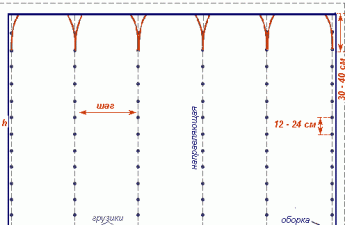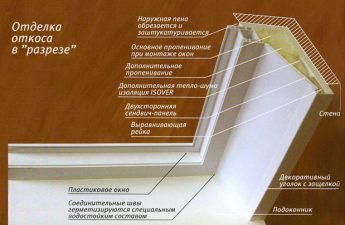The traditional solution in window design has always beena duet of curtain drapes and curtains is used. If the former are usually sewn from more durable and opaque fabrics, then in the design of the latter, light and flowing organza, veil or tulle fabrics are used. And very long curtains and curtains are one of the latest stylistic trends in window design.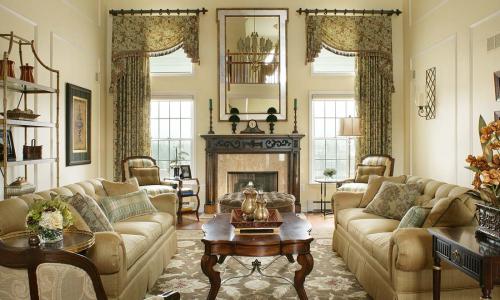 Curtains and drapes should fit into the overall interior of the living room.
Curtains and drapes should fit into the overall interior of the living room.
Selecting the texture of the fabric
When decorating a window opening, designersrecommend choosing curtains and drapes in accordance with the overall decoration of the room, with the texture of the furniture and carpet. The interior in a romantic or classic style provides for the lightness of curtains with patterns and embroidery. Laconicism in the minimalist style will ideally weave functional curtains with a barely noticeable printed pattern on the fabric or without it into the design of the room. Batiste materials are a modern solution in the decoration of rooms not cluttered with furnishings (Fig. 1).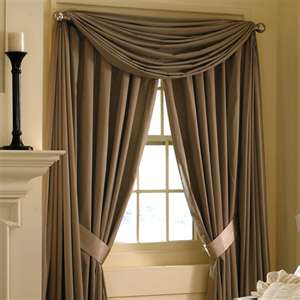 Figure 1.Batiste curtains are very light in texture and do not clutter up the space of the room. Modern light industry, both domestic and imported, offers natural and artificial materials. Wool, linen, silk fabrics are pleasant to the touch, visually noble, but require more careful care. When using them in the house, you will have to do not only with washing, but also with dry cleaning. Artificial fabric is a tribute to an economical, simple and more durable option. It is worth thinking about the degree of transparency of curtains if they are selected for bedrooms or living rooms. In bedroom design, preference is given to thick curtains. As for the curtain, the fabric for it can be traditional chiffon or organza. The latter is a modern trend in window design, representing a fabric with a spraying that gives the material a shimmer and shine. The effect of spraying on the fabric sometimes creates a visualization of the northern lights, shimmering snow or sparkling sun. According to designers' recommendations, organza curtains can be used without curtains in a single or double panel on the window space. In this case, organza should be chosen with wool or mohair threads woven into it, which gives the fabric density and less transparency. This option is also ideal for living rooms, especially if the apartments are located on the upper floors, where the owners do not always curtain the windows, and the use of curtains is reduced to a minimum. Return to contents</a>
Figure 1.Batiste curtains are very light in texture and do not clutter up the space of the room. Modern light industry, both domestic and imported, offers natural and artificial materials. Wool, linen, silk fabrics are pleasant to the touch, visually noble, but require more careful care. When using them in the house, you will have to do not only with washing, but also with dry cleaning. Artificial fabric is a tribute to an economical, simple and more durable option. It is worth thinking about the degree of transparency of curtains if they are selected for bedrooms or living rooms. In bedroom design, preference is given to thick curtains. As for the curtain, the fabric for it can be traditional chiffon or organza. The latter is a modern trend in window design, representing a fabric with a spraying that gives the material a shimmer and shine. The effect of spraying on the fabric sometimes creates a visualization of the northern lights, shimmering snow or sparkling sun. According to designers' recommendations, organza curtains can be used without curtains in a single or double panel on the window space. In this case, organza should be chosen with wool or mohair threads woven into it, which gives the fabric density and less transparency. This option is also ideal for living rooms, especially if the apartments are located on the upper floors, where the owners do not always curtain the windows, and the use of curtains is reduced to a minimum. Return to contents</a>
Original curtains decoration
Window design using curtains and drapesalways creates a comfortable atmosphere of a finished interior in the living room. Such a touch as adding an upper lambrequin is known to everyone. But, in addition to this detail, designers add the following elements to the curtain decoration: Figure 2. Using draping fabric and curtain clips, you can create beautiful compositions for your curtains.
Figure 2. Using draping fabric and curtain clips, you can create beautiful compositions for your curtains.
- lambrequins;
- ruches and flounces;
- braid and beads;
- tapes;
- cords and cords;
- eyelets, etc.
Lambrequin, due to its hanging structure, is capable ofhave the function of decoration and, at the same time, concealing some of the curtains’ shortcomings. Being a piece of fabric of a straight or original shape, with the help of various options for hanging it in combination with curtain fabric, a lambrequin is able to create bizarre compositions on the window. This is achieved by draping the fabric and using curtain clips (Fig. 2). Another variation of curtain design using a lambrequin is called “French curtains”. They are several fabric sections that, with the help of numerous draperies, create a luxurious composition on the window. Due to the majestic texture, such curtains are recommended to be hung not only in living rooms, but also in dining rooms, offices and halls. The main principle in such a window frame is the impeccability of numerous folds. The fabric should not be too dense in texture so that it can be easily draped. This trend is brilliantly implemented by numerous curtain design studios, whose services can be used by those owners who are unable to drape the curtains themselves.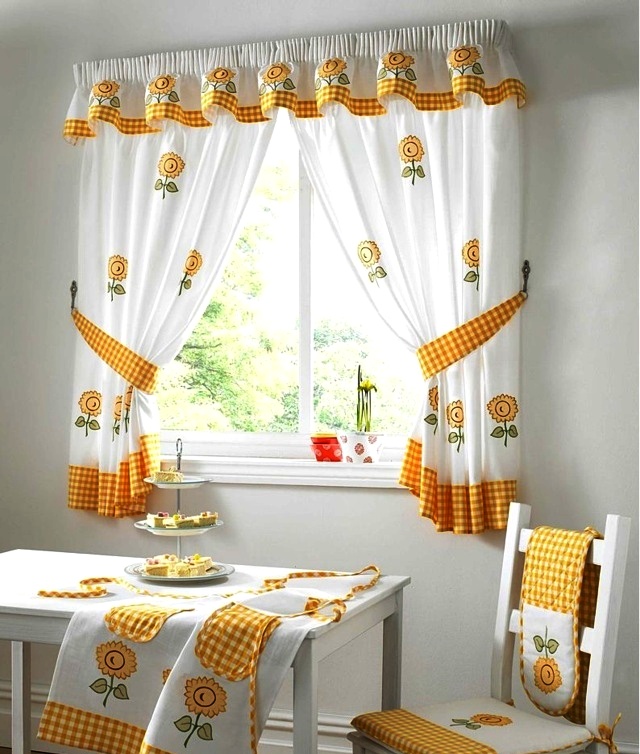 Figure 3.For multi-colored curtains, the color of the tape can be one of those present in the color palette of the fabric. Ruffles and flounces add variety to the design of the curtain. They are sewn onto the edge of the fabric on a regular tulle canvas and add airiness and sophistication together with embroidery. Such an installation in the window design is ideal for bedrooms and children's rooms, as well as kitchens in the style of Provence, country and shabby chic. Tape looks advantageous on the fabric of curtains and drapes. Satin, woven or lace ribbons are sewn along the edge of the material, as well as ruffles. If the curtain ensemble includes a lambrequin, then the tape should be placed along its edge. From the remains of the tape material, you can make decorative rosettes-grabs for the curtains. The color of the tape is chosen in a contrasting shade, if the color of the main fabric is monochromatic. For multi-colored curtains, the shade of the tape can be one of the colors present in the palette of the fabric (Fig. 3). Beads are good to use as an accompanying decoration of curtains. They are sewn onto the edge of the curtain panels, and when the curtains are closed, they will create an effective decorative touch. You can continue decorating with beads in the design of the grab for both curtains. If beads are used in the design of the curtain, a string of beads is usually used to grab the curtain in the middle of the fabric. Return to contents</a>
Figure 3.For multi-colored curtains, the color of the tape can be one of those present in the color palette of the fabric. Ruffles and flounces add variety to the design of the curtain. They are sewn onto the edge of the fabric on a regular tulle canvas and add airiness and sophistication together with embroidery. Such an installation in the window design is ideal for bedrooms and children's rooms, as well as kitchens in the style of Provence, country and shabby chic. Tape looks advantageous on the fabric of curtains and drapes. Satin, woven or lace ribbons are sewn along the edge of the material, as well as ruffles. If the curtain ensemble includes a lambrequin, then the tape should be placed along its edge. From the remains of the tape material, you can make decorative rosettes-grabs for the curtains. The color of the tape is chosen in a contrasting shade, if the color of the main fabric is monochromatic. For multi-colored curtains, the shade of the tape can be one of the colors present in the palette of the fabric (Fig. 3). Beads are good to use as an accompanying decoration of curtains. They are sewn onto the edge of the curtain panels, and when the curtains are closed, they will create an effective decorative touch. You can continue decorating with beads in the design of the grab for both curtains. If beads are used in the design of the curtain, a string of beads is usually used to grab the curtain in the middle of the fabric. Return to contents</a>
Modernized decor of curtains
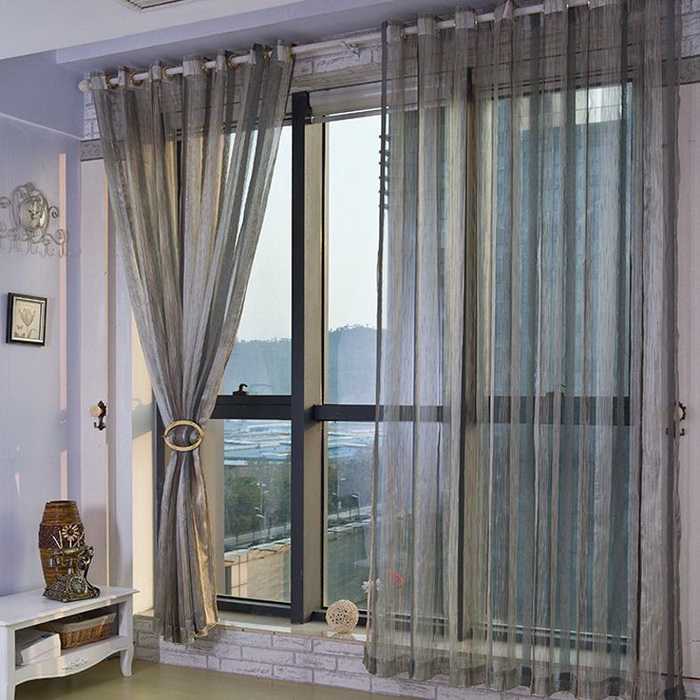 Figure 4.An organza curtain can create an original design even without additional curtains. Decorating curtains with cords is the most traditional and favorite way of window design for many. Cords of different thickness with tassels or pompoms at the ends act as grips for curtains and individual elements in the folds of lambrequins. Cords are usually used in pairs of "curtains and drapes". In this way, an effect of playful nobility is created on the window and in the interior of the room. This option is optimal for classic interiors of large halls and living rooms with high ceilings, since the feigned massiveness of the entire decoration for small rooms will be cumbersome. Modern versions of window displays suggest using eyelets or ribbons instead of tucks on the cornice. The curtain material should be heavy and durable, since the holes in the eyelets, holding the curtain on the cornice, create the most correct drapery of the fabric. In some cases, designers manage to hang curtains on eyelets. In this case, the same organza of a denser structure or chiffon will look ideal. With their texture, they are able to independently, without the addition of curtain fabrics, create an original solution in the interior (Fig. 4). If instead of tucks you use fabric loops for the cornice, which are sewn onto the curtain or curtain fabric, then this will undoubtedly add a twist to the window design. You can sew such loops yourself, or you can buy ready-made curtains with them.
Figure 4.An organza curtain can create an original design even without additional curtains. Decorating curtains with cords is the most traditional and favorite way of window design for many. Cords of different thickness with tassels or pompoms at the ends act as grips for curtains and individual elements in the folds of lambrequins. Cords are usually used in pairs of "curtains and drapes". In this way, an effect of playful nobility is created on the window and in the interior of the room. This option is optimal for classic interiors of large halls and living rooms with high ceilings, since the feigned massiveness of the entire decoration for small rooms will be cumbersome. Modern versions of window displays suggest using eyelets or ribbons instead of tucks on the cornice. The curtain material should be heavy and durable, since the holes in the eyelets, holding the curtain on the cornice, create the most correct drapery of the fabric. In some cases, designers manage to hang curtains on eyelets. In this case, the same organza of a denser structure or chiffon will look ideal. With their texture, they are able to independently, without the addition of curtain fabrics, create an original solution in the interior (Fig. 4). If instead of tucks you use fabric loops for the cornice, which are sewn onto the curtain or curtain fabric, then this will undoubtedly add a twist to the window design. You can sew such loops yourself, or you can buy ready-made curtains with them.
